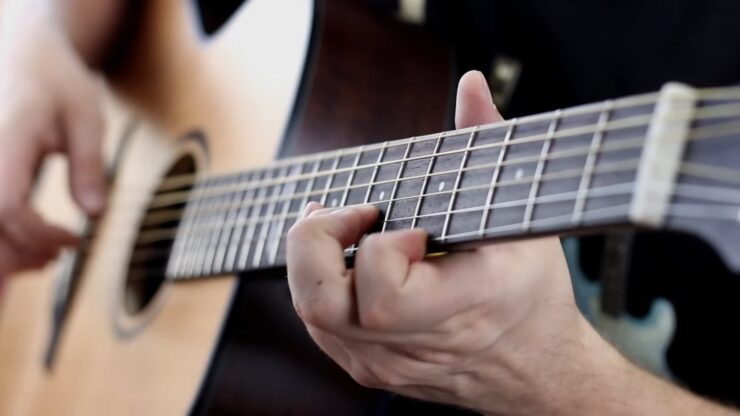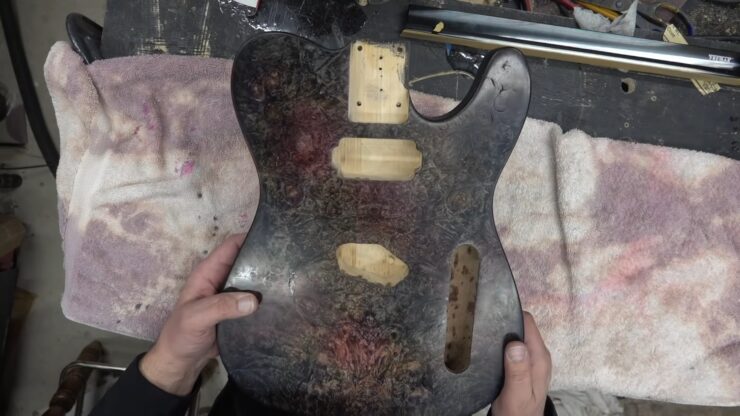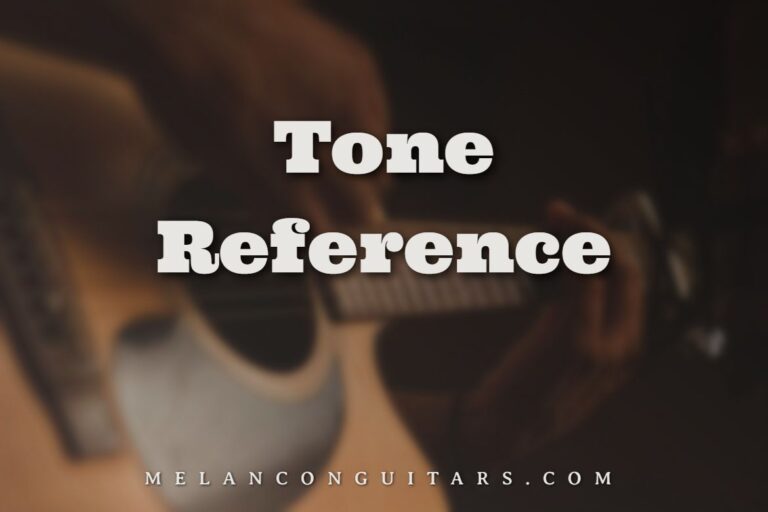I usually avoid discussions on tone for the following reason. The tone is very subjective and the descriptions of tone can be somewhat misleading. Anytime tone is mentioned, we have to always consider one of the primary tone generators: your Hands! Each individual’s hands produce a tone that is unique. The list that follows is my personal attempt to give you a complete description of the woods we offer and their characteristics.
1. Alder
This is probably one of the most widely used woods in the late 50?s and 60?s for 3 single coil style guitars. This wood will produce a very familiar “vintage tone” It is a clear and articulate sounding wood with a thick mid-range tone. Alder is medium to light in weight and has a medium tan color with very little pronounced grain pattern. This wood looks good with sunburst and a few selected transparent colors including reds, greens, and yellows.
Check out our Swampcaster guitar review.
2. Louisiana Swamp Ash
Swamp Ash is just waiting to resonate! This is the other “vintage wood” used in single coil type guitars from the 50?s and 60?s. The ash we use is lighter in weight and less harsh sounding than regular ash. Its color is a light blonde with darker brown grain patterns. This wood looks good in all transparent colors. Being located down in Louisiana, we know a little about swamp ash. All of the good ash grows in the swamps and bayous of the deep south. The best part of the tree is near the water line so we have to fight off the gators and snakes! T-Fred Boudreaux (Boo-Dr-O) is our main logger. Nuthin? scares him!
3. Basswood
Stong midrange, balanced tone, and light weight. Light blonde in color with no grain. This guitar is a nice backing wood for maple tops when combined with humbuckers. Usually, look best with opaque color on the back and transparent color on the maple tops.
4. Sugar Pine
Sugar Pine imparts a nice punchy, round and full sound with a bit less top-end snap than Swamp Ash. It also has more sustain. Another positive to Sugar Pine is it’s exceptionally low weight. Sugar Pine is a soft wood so it can be more susceptible to dents and dings.
5. Mahogany

The tone of mahogany is thick and with pronounced mids. It has a mid to mid-heavy weight. The grain is mild and color is medium brown which looks good natural or with red or orange tints. Mahogany has very good sustain.
6. Korina
Its true name is Limba and comes from Africa. White Korina is a medium to heavy weight wood and has a naturally waxy feel to it. The tone is very similar to Mahogany with added mids. Please call for availability.
7. Black Limba
This wood is also Limba (Korina) from Africa. Black Limba is a medium weight wood. It has a very beautiful olive color with black streaking and has a naturally waxy feel to it. The tone is very similar to Mahogany with added mids. Please call for availability.
8. Quilted Maple Top
Quilted maple is a more rare form of figure occurring mostly in western maple. It is distinguished by its billowing cloud or even popcorn appearance. This figure can vary from large, wide billows to tight small blisters. It is used as a bookmatched top.
9. Flame Maple Top
Flame, Fiddle-Back, Curly, or Tiger maple all refer to the curls (or stripes) as illustrated here. Flame can be tight, wide, straight, or crooked. It is used for bookmatched tops.
10. Spalted Maple
Spalt is actually the product of a dead or decaying tree. The black lines are created by the fungal attacks and the different colors are varying degrees of decay. This wood is soft and can be punky and is only used as bookmatched tops.
11. Burl Maple

A burl results from a tree undergoing some form of stress. It may be caused by an injury, virus, or fungus. Most burls grow beneath the ground, attached to the roots as a type of malignancy. Such burls sometimes appear as groups of bulbous protrusions. This is a very busy looking wood and can be porous and have bark inclusions. Burl is used for bookmatched tops. Epoxy is used to fill any voids.
12. Figured Redwood
Figured redwood has a reddish color and is only available in a few transparent colors and bursts. It is available only as bookmatched laminate tops on flat top solid bodies. The figuring can range from a very wide flame to wide curls.
13. Flamed Koa
This very beautiful wood comes exclusively from Hawaii making supply very limited. It is deep reddish brown or golden orangish brown in color with a flame grain pattern. Most customers don’t want to cover the natural beauty of koa, therefore we offer the tops in Natural, Koaburst (Tobacco edge), and Cherry burst. Tonally, Koa tops are similar to maple tops but will add a touch more focused upper-mid influence on the sound of the backing wood.
-
Alder Back / Maple Top
This combination produces a full sound with good balance in all registers with equal doses of lows, mids and highs.
-
Basswood Back / Maple Top
This combination produces a full sound with good balance in the low, middle, and higher registers. An excellent choice for humbuckers! Sounds great when combined with a maple fingerboard.
-
Swamp Ash Back / Maple Top
Nice punch with scooped mids. Very alive and vibrant with an open ring and nice clarity. Sounds great clean and dirty! Lightweight and looks good with all transparent colors.
-
Mahogany Back / Maple Top
Looking for something to really cut through the mix? This combination is thick and powerful in the middle with lots of clarity. It is not as harsh sounding as many people would think. The weight is mid to mid-heavy and looks good with natural back or many transparent colors.
If you’re interested in more posts about guitars go to melanconguitars.com and expand your knowledge.

